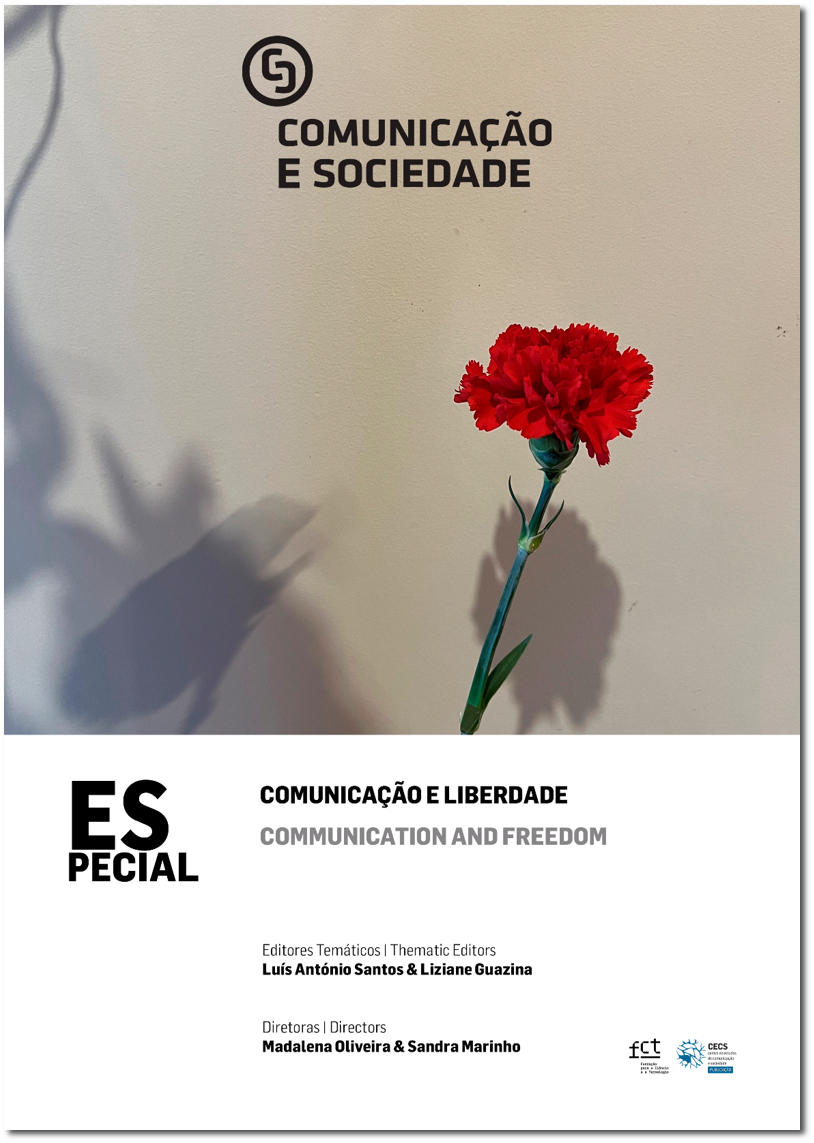"A Consciência da Revolução Síria": Criatividade na Busca pela Liberdade nas Faixas de Kafranbel (2011-2018)
DOI:
https://doi.org/10.17231/volesp(2025).5474Palavras-chave:
Kafranbel, Síria, liberdade de expressão, narrativa cidadã, mídiaResumo
Este artigo examina a narrativa revolucionária e o processo de comunicação de Kafranbel, uma cidade no norte da Síria amplamente reconhecida como “a consciência da revolução síria”. Célebre pelas suas emblemáticas faixas e cartazes, a produção da cidade decorreu entre 2011 e 2018, abrangendo imagens de pessoas a segurar faixas e cartazes com mensagens escritas, desenhos e caricaturas. Estas faixas e cartazes eram regularmente partilhados nas redes sociais, refletindo um processo criativo dinâmico e em constante evolução. Este estudo recorre a uma metodologia de investigação descritiva e qualitativa para analisar um conjunto de imagens (n = 214) compiladas e organizadas cronologicamente. Além disso, integra na análise as perceções de nove entrevistas semiestruturadas conduzidas em espanhol, inglês e árabe. Estas entrevistas, realizadas junto de residentes, testemunhas e especialistas que acompanharam de perto a revolta, proporcionam uma visão abrangente dos esforços de comunicação de Kafranbel.
As conclusões destacam a forma como as faixas e cartazes de Kafranbel surgiram e se consolidaram como resposta à repressão do regime sírio e à crescente ameaça representada por grupos extremistas, incluindo o Estado Islâmico do Iraque e da Síria (Daesh). A narrativa da cidade recorreu a elementos persuasivos e centrados no ser humano, como a representação de crianças e referências a lutas e ícones globais, para envolver tanto o público local como internacional. A análise das faixas e cartazes revela uma mudança no tom e nas escolhas linguísticas à medida que o conflito se intensificava e a cidade se via cada vez mais desesperada por auxílio. A ausência de faixas e cartazes durante períodos de bombardeamento intenso evidencia as duras realidades enfrentadas pelos residentes, culminando no silêncio da cidade após a sua recaptura pelo regime sírio e o assassinato do jornalista Raed Fares por homens armados afiliados ao Daesh. Este estudo preenche uma lacuna significativa na investigação existente, oferecendo uma análise detalhada da estratégia de comunicação singular de Kafranbel no contexto mais amplo da revolta síria.
Downloads
Referências
Abboud, S. N. (2018). Syria: Hot spots in global politics. Polity Press.
Adi, M.-M. (2014). The usage of social media in the Arab Spring. LIT Verlag.
Ahmad, A. R., & Hamasaeed, H. H. (2015). The role of social media in the Syrian Uprising. Journal of Economic Development, Environment and People, 4(2), 39–48. https://doi.org/10.26458/jedep.v4i2.105
Al Natour, M. (2022). Home, identity, and place in Syrian literature: Maha Hassan's Drums of Love and Ghassan Jubbaʿi's Qahwat Al-General. Contemporary Levant, 7(1), 66–80. https://doi.org/10.1080/20581831.2022.2058717
Allaf, R. (2012, January 17). Syrian women, backbone of the revolution. Media Monitors Network. https://www.mediamonitors.net/syrian-women-backbone-of-the-revolution/
Alshab, A. (2021). Centralization and decentralization in Syria: Comparison of before and after 2011 [Master's thesis, Hasan Kalyoncu Üniversitesi].
Alvarez-Ossorio, I. (2012). Syria's struggling civil society and the Syrian uprising. Middle East Quarterly, 19(2), 23–32.
Álvarez-Ossorio, I. (2017). Siria: Revolución, sectarismo y Yihad. Los Libros de la Catarata.
Álvarez-Ossorio Alvariño, I. (2015). El enroque autoritario del régimen sirio: De la revuelta popular a la guerra civil. Revista CIDOB d'Afers Internacionals, (109), 157–176.
Álvarez-Ossorio Alvariño, I., & Nachawati Rego, L. (2023). Dinámicas de resistencia civil en Siria desafiando al régimen autoritario. In C. Pérez Beltrán (Ed.), Dinámicas de protestas en el mundo árabe: Desafiando a los regímenes autoritarios (pp. 279–308). Editorial Universidad de Granada.
Assad: The end of war on Syria is imminent. (2018, October 4). Roya News. https://en.royanews.tv/news/56959
Awad, S. H., & Wagoner, B. (Eds.). (2018). Street art of resistance. Palgrave Macmillan.
Bachleitner, K. (2022). Legacies of war: Syrian narratives of conflict and visions of peace. International Studies Quarterly, 57(1), 43–64. https://doi.org/10.1177/00108367211032691
Bachleitner, K., & Matthiesen, T. (2021). Introduction to themed section on 'Belonging to Syria: National identifications before and after 2011'. Nations and Nationalism, 28(1), 117–124. https://doi.org/10.1111/nana.12784
Badawi, H. (2023). Pro-Syrian regime versus anti-regime outlets: A comparative critical discourse analysis. International Journal of Management and Humanities, 9(10), 8–14. https://www.doi.org/10.35940/ijmh.J1619.0691023
Barthes, R. (1977). Image-music-text (S. Heath, Trans.). Hill and Wang. (Original work published 1964).
Ben Moussa, M. (2013). From Arab street to social movements: Re-theorizing collective action and the role of social media in the Arab Spring. Westminster Papers in Communication and Culture, 9(2), 47–68. https://doi.org/10.16997/wpcc.166
Bonnefoy, L., & Louer, L. (2021). Le Printemps Arabe dans la péninsule Arabique. CERI - Centre de Recherches Internationals, (4). https://doi.org/10.4000/cy.2803
Brown, H., Guskin, E., & Mitchell, A. (2012). The role of social media in the Arab uprisings. Pew Research Center.
Brym, R., Godbout, M., Hoffbauer, A., Menard, G., & Zhang, T. H. (2014). Social media in the 2011 Egyptian uprising. The British Journal of Sociology, 65, 266–292. https://doi.org/10.1111/1468-4446.12080
Camps-Febrer, B. (2013). Political humor as a confrontational tool against the Syrian regime; a study case: Syria, 15th March 2011 – 15th May 2012. International Catalan Institute for Peace. https://doi.org/10.2139/ssrn.2205200
Couldry, N. (2008). Mediatization or mediation? Alternative understandings of the emergent media environment. New Media & Society, 10(3), 315–336. https://doi.org/10.1177/1461444808089414
Crotty, M. (1998). The foundations of social research: Meaning and perspective in the research process. SAGE.
Della Ratta, D. (2018). Shooting a revolution: Visual media and warfare in Syria. Pluto Press.
Dibo, M. (2013, December 21). Kafranbel: The conscience of the revolution. SyriaUntold. https://syriauntold.com/2013/12/21/kafranbel-the-conscience-of-the-revolution/
Durand, J. (1982). Retórica e imagen publicitaria (M. T. Cevasco, Trans.). In C. Metz, U. Eco, J. Durand, G. Péninou, V. Morin, S. Du Pasquier, P. Fresnault-Deruelle, C. Metz, J. Bertin, L. Marin, & J.-L. Schefer (Eds.), Análisis de las imágenes (pp. 81–115). Ediciones Buenos Aires. (Original work published 1970)
El Khannoussi, J. (2012). Factores internos y externos de la revolución siria. Revista Internacional de Pensamiento Político, 7, 27–41.
El Omari, H., El Fakir, M., & Şaban, N. (2016). The political role of local councils in Syria: Survey results. Omran Center for Strategic Studies.
Espiritusanto, O., & Rodríguez, P. G. (2011). Periodismo ciudadano: Evolución positiva de la comunicación. Ariel; Fundación Telefónica.
Geertz, C. (1973). The interpretation of cultures: Selected essays. Basic Books.
Ghannam, J. (2011). Digital media in the Arab world: The impact of social media on political change (Arab Social Media Report, 10-25-11). Brookings Institution.
Gitlin, T. (1980). The whole world is watching: Mass media in the making and unmaking of the new left. University of California Press.
Graham-Harrison, E. (2018, November 23). Influential Syrian activist Raed Fares gunned down in Idlib. The Guardian. https://www.theguardian.com/world/2018/nov/23/influential-syrian-activist-raed-fares-gunned-down-in-idlib
Griswold, E. (2014, December 4). Radio-free Syria. The New York Times. https://www.nytimes.com/2014/12/07/magazine/radio-free-syria.html
Guedes, A. M., & Costa, R. D. (Eds.). (2019). O “grande Médio Oriente” alargado (Vol. 1). Instituto Universitário Militar.
Hanano, A. (2013, October 18). Rising up and rising down: In Syria's little town that could, the death and resurrection of the witty, profane campaign to show the world the tragedy of civil war. Foreign Policy. https://foreignpolicy.com/2013/10/18/rising-up-and-rising-down/
Howard, P. N., Duffy, A., Freelon, D., Hussain, M. M., Mari, W., & Maziad, M. (2011). Opening closed regimes: What was the role of social media during the Arab Spring? https://doi.org/10.2139/ssrn.2595096
Hubbard, B. (2018, November 23). Activist who used humor to highlight war is gunned down in Syria. The New York Times. https://www.nytimes.com/2018/11/23/world/middleeast/syria-fares-activist-killed.html
Hurtado, L. M. (2014, January 6). Asalto rebelde al feudo de la milicia yihadista ISIS en Siria. El Mundo. https://www.elmundo.es/internacional/2014/01/06/52cb0e0522601dba098b457a.html
Jurgenson, N. (2012). When atoms meet bits: Social media, the mobile web and augmented revolution. Future Internet, 4(1), 83–91. https://doi.org/10.3390/fi4010083
Kachee, A. (2013). Trajectoires de villes syriennes dans la révolution. Vers l'émergence d'une citoyenneté? Confluences Méditerranée, (85), 103–113.
Karadjis, M. (2019). Review of the book State Propaganda in Syria: From War Crimes to Pipelines, by N. Ahmed. State Crime Journal, 8(1), 167–170.
Karim, S., & Islam, M. N. (2016). Syrian crisis: Geopolitics and implications. BIISS Journal, 37(2), 107–132. https://biiss.org/publication-view/1350356258732904448
Khalaf, R. (2015). Governance without government in Syria: Civil society and state building during conflict. Syria Studies, 7(3), 37–72.
Khamis, S., Gold, P. B., & Vaughn, K. (2012). Beyond Egypt's "Facebook Revolution" and Syria's "YouTube Uprising:" Comparing political contexts, actors, and communication strategies. Arab Media and Society. https://www.arabmediasociety.com/beyond-egypts-facebook-revolution-and-syrias-youtube-uprising-comparing-political-contexts-actors-and-communication-strategies/
Khondker, H. H. (2011). Role of the new media in the Arab Spring. Globalizations, 8(5), 675–679. https://doi.org/10.1080/14747731.2011.621287
Lynch, M., Freelon, D., & Aday, S. (2014). Syria in the Arab Spring: The integration of Syria’s conflict with the Arab uprisings, 2011–2013. Research & Politics, 1(3). https://doi.org/10.1177/2053168014549091
Magnarella, P. J. (2017). Middle East and North Africa: Governance, democratization, human rights. Routledge.
McLuhan, H. M., & Fiore, Q. (1967). The medium is the massage. Bantam Books.
Pedersen, M. A., Albris, K., & Seaver, N. (2021). The political economy of attention. Annual Review of Anthropology, 50, 309–325. https://doi.org/10.1146/annurev-anthro-101819-110356
Raed Fares: Syria radio host shot dead in Idlib. (2018, November 24). BBC. https://www.bbc.com/news/world-middle-east-46320355
Ramírez Díaz, N. (2016). Against all odds: Defining a revolutionary identity in Syria. In A. Douai & M. Ben Moussa (Eds.), Mediated identities and new journalism in the Arab world (pp. 83–99). Springer.
Ruiz de Elvira, L. (2011). Siria, el largo camino hacia la revolución. Revista de Estudios Internacionales Mediterráneos, 10, 33-46. Universidad Autónoma de Madrid. Taller de Estudios Internacionales Mediterráneos. https://hdl.handle.net/10486/670294
Saleh, Y. A. H. (2017). The impossible revolution: Making sense of the Syrian tragedy. Oxford University Press.
Scartozzi, C. M. (2015). Assad's strategic narrative: The role of communication in the Syrian civil war. Contemporary Review of the Middle East, 2(4), 313–327. https://doi.org/10.1177/2347798915610037
Simon, H. (1971). Designing organizations for an information-rich world. Johns Hopkins Press.
Sylvester, C. (Ed.). (2015). Masquerades of war. Taylor & Francis.
Tufekci, Z., & Wilson, C. (2012). Social media and the decision to participate in political protest: Observations From Tahrir Square. Journal of Communication, 62(2), 363–379. https://doi.org/10.1111/j.1460-2466.2012.01629.x
United Nations. (2021, March 12). Syria war: Average of one child injured or killed every eight hours over the past 10 years. https://news.un.org/en/story/2021/03/1087212
Wall, M. (2015). Citizen journalism: A retrospective on what we know, an agenda for what we don't. Digital Journalism, 3(6), 797–813. https://doi.org/10.1080/21670811.2014.1002513
Wedeen, L. (2013). Ideology and humor in dark times: Notes from Syria. Critical Inquiry, 39(4), 841–873. https://doi.org/10.1086/671358
Wengraf, T. (2001). Qualitative research interviewing: Biographic narrative and semi-structured methods. SAGE.
Wessels, J. I. (2015). Syrian masquerades. In C. Sylvester (Ed.), Masquerades of war (pp. 95–117). Taylor & Francis.
Yassin-Kassab, R., & Al-Shami, L. (2016). Burning country: Syrians in revolution and war. Pluto Press.
Yin, R. K. (2014). Case study research: Design and methods. SAGE.
Zarwan, E. (2005). False freedom: Online censorship in the Middle East and North Africa. Human Rights Watch. https://www.hrw.org/report/2005/11/14/false-freedom/online-censorship-middle-east-and-north-africa
Downloads
Publicado
Como Citar
Edição
Secção
Licença
Direitos de Autor (c) 2025 Leila Nachawati Rego

Este trabalho encontra-se publicado com a Licença Internacional Creative Commons Atribuição 4.0.
Os autores são titulares dos direitos de autor, concedendo à revista o direito de primeira publicação. O trabalho é licenciado com uma Licença Creative Commons - Atribuição 4.0 Internacional.












